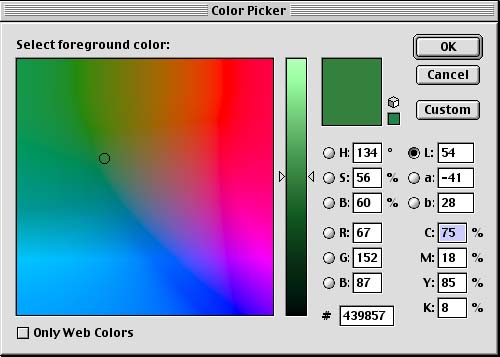Part Seven - Color Management
by Chuck Gardner
|
Color space definition via profiles
The fact that three different desktop color standards had emerged around Apple monitor, PressView, and PC monitors created a real problem when color files were exchanged between computers. It was further aggrievated if the RGB files were converted to CYMK for printing because not all of the colors which appeared on the monitor could be printed as this 3D comparison of ColorMatch RGB and CYMK colorspace illustrates. A solution to the desktop color chaos was devised in 1993 by an international consortium of companies (International Color Consortium or ICC) in the color reproduction business was to create a standardized system to convert color between devices and define industry standard conditions used when viewing a file on a monitor. Under the ICC profiling system the various monitor viewing conditions then in use such as Apple monitor, PressView monitor, and PC monitor were formalized as Apple RGB, ColorMatch RGB, and sRGB "working" or "display" profiles. Several other new display color spaces such as Adobe RGB (1998) and Wide Gamut RGB were also defined. Each RGB working space was mapped to a common Profile Connection Space (PCS). The PSC selected by ICC was the well established CIE L*a*b colorspace which encompasses the range of human vision. The second important part of the ICC color management equation was the development of software and video cards which could recognize ICC profile "tags" on files and then precisely alter the output of the red, green, and blue electron "guns" in the computer monitor to dynamically create any of the standard display conditions. Photospectometers and colorimeters are now used to measure the range of color each RGB device or CYMK ink set can reproduce relative to the colors of the visible spectrum is the gamut of CIE L*a*b colorspace, producing an "ICC Profile" which are used as the roadmap for moving RGB color from scanner or camera, to monitor, and printer without getting lost on the way. ColorSync Information and tutorials about ColorSync workflows can be found at:http://www.apple.com/colorsync/ ColorSync and the ColorSync logo are trademarks of Apple Computer, Inc., registered in the U.S. and other countries. The Made with ColorSync Badge is a trademark of Apple Computer, Inc., used with permission. PhotoShop adds ColorSync and CIE L*a*b Starting with version 5, Photoshop incorporated ColorSync and ICC color management, making CIE L*a*b the default colorspace for Photoshop files and making it possible to easily determine the RGB, CIE L*a*b values, and CYMK values for any color using the color picker. 
The PhotoShop color picker illustrated above shows that the selected green color which has a CIE L*a*b value of L=54 (i.e., midway between white and black), a=-41 (i.e. more green than red), and b=28 (i.e., more yellow than blue) also can be described in terms of RGB values ( R=67, G=152, B = 87) or the dot percentages of CYMK inks needed to reproduce it (C=75% M=18% Y=85% K=8%). Goto Next Page > Goto < Previous Page Goto Class Outline Goto super.nova.org my home page. |